CONTENTS
- Implementing Universal Health Coverage
- Youth Suicide Rates in India
Implementing Universal Health Coverage
Context:
Universal health coverage (UHC) embodies the principle of providing all individuals with unrestricted access to comprehensive, top-tier healthcare services, without imposing financial burdens. UHC guarantees that individuals can access healthcare whenever and wherever they require it, encompassing a wide range of essential health services, spanning from health promotion and prevention to treatment, rehabilitation, and palliative care. The provision of these services relies on robust, efficient, and fair healthcare systems deeply embedded within communities.
Relevance:
GS2- Health
Mains Question:
A populace in good health is a populace empowered. In this context, discuss the constitutional safeguards available to ensure universal Health Coverage (UHC). What place does health occupy in the political parties’ proposition(s) for the upcoming Lok Sabha elections? (15 Marks, 250 Words).
More About Universal Health coverage (UHC):
- UHC is founded on the idea of enhancing primary healthcare to ensure the holistic addressing of all health needs, backed by a skilled and adequately supported healthcare workforce.
- On December 12, 2012, the United Nations General Assembly unanimously supported a resolution urging nations to hasten their advancements towards Universal Health Coverage (UHC).
- In India, the high-level expert group’s report, presented to the Planning Commission in 2011, outlined the government’s intention to boost public healthcare financing to 2.5% of India’s GDP during the 12th Plan (2012-17). The country’s economic growth makes this increase achievable.
- The National Health Policy of 2017 articulates its goal as “achieving the highest possible level of health and well-being, and ensuring universal access to high-quality healthcare services without imposing financial hardship on anyone,” which is in line with the objectives of UHC.

Constitutional Safeguards:
In India, there is no explicit constitutional provision establishing the fundamental right to basic health.
- However, the Directive Principles of State Policy outlined in Part IV of the Constitution serve as a foundation for the right to health.
- Article 39 (e) of the Constitution mandates the state to ensure the health protection of workers; Article 42 underscores the importance of fair and humane working conditions and maternity benefits; while Article 47 obligates the state to elevate nutrition levels, raise the standard of living, and enhance public health.
- Notably, the Constitution not only requires the state to promote public health but also delegates authority to local governing bodies such as panchayats and municipalities to bolster public health under Article 243G.
Significance of UHC:
- The International UHC day theme, ‘Health for all: Time for Action,’ and the World Health Day theme, ‘my health – my right,’ prompt a consideration of how access to healthcare should be conceptualized.
- Given that health falls under state jurisdiction and UHC policies are crafted at the national level, there’s a pressing need for discussions on implementation.
- India’s substantial migrant population, with approximately 41 million inter-state migrant workers (Census 2011) and a migration rate of 28.9% (Periodic Labour Force Survey, 2020-21), along with 49% of the population residing in urban slums (UN-Habitat/World Bank), highlights the importance of prioritizing the availability and accessibility of primary healthcare services.
- Isaiah Berlin delineated two forms of freedom: ‘freedom from’ or negative freedom, and ‘freedom to’ or positive freedom.
- ‘Freedom from’ entails the absence of hindrances or constraints, whereas ‘freedom to’ acknowledges the capacity to independently determine and achieve individual or collective goals.
- The discourse surrounding health as a human right should align with the concept of ‘freedom to,’ where every citizen has the opportunity to attain health and well-being as part of their entitlement to access public health services.
- The constitutional entitlement to health plays a pivotal role in disrupting the harmful cycle of poverty and ill health, which would otherwise sustain inequality across various domains such as education, opportunities, wealth, and social mobility.
- Addressing the two key aspects of the UHC policy – enhancing primary healthcare and diminishing out-of-pocket expenses – requires dedicated focus.
Way Forward:
Addressing the Healthcare Needs of Urban Migrants:
- The first suggestion is to address the healthcare needs of urban migrants and initiate reforms in informal sectors.
- Given the significant increase in migration and mobility, there is a necessity for a paradigm shift in the vision of primary healthcare.
- It’s crucial to incorporate the aspect of mobility and the portability of healthcare access to facilitate the continuity of treatment.
Reducing Out-of-Pocket Expenses:
- The second recommendation is to streamline reimbursement processes to reduce out-of-pocket expenses.
- The structure of cash transfers and reimbursements within India’s public healthcare system needs adjustments to accommodate migrant and marginalized communities.
Establish Inclusive Health Systems:
The third suggestion is to establish inclusive health systems. Efforts should be made to integrate health management information system dashboards with both public and private healthcare systems, ensuring improved information systems that consider language barriers and the diversity present in urban areas.
Implementing Community-Based Primary Healthcare:
- The fourth recommendation involves implementing community-based primary healthcare in urban and peri-urban areas, alongside seamless referral systems.
- It is essential to promote the integration of services at the primary healthcare level, ensuring proper follow-up and adherence to healthcare protocols.
Conclusion:
A populace in good health is a populace empowered. A lower disease burden translates to stronger financial health for the country. In this election cycle, Universal Health Coverage (UHC) can represent a transformative proposition from political parties. Committing to invest in health systems and effectively implementing UHC requires political determination, significant financial commitment, and a clear, long-term vision. Establishing a coherent policy framework to consistently execute the national UHC policy across states is crucial for its success.
Youth Suicide Rates in India
Context:
India holds the unfortunate distinction of having the highest number of suicides globally. According to the National Crime Records Bureau (NCRB), 1.71 lakh individuals died by suicide in 2022. The suicide rate has surged to 12.4 per 1,00,000 individuals – the highest rate ever documented in India. However, these statistics are likely underestimated due to deficiencies in the registration system, absence of medical certification of death, societal stigma, and other contributing factors.
Relevance:
- GS1- Population and Associated Issues
- GS-2-
- Government Policies and Interventions
- Health
Mains Question:
Discuss the factors responsible for the rising suicide rates among youth in India. What can be done at the individual and government levels to minimise its occurrence. (15 Marks, 250 Words).
Relevant Statistics:
- Alarmingly, 41% of all suicides are committed by individuals below the age of 30, with suicide emerging as the leading cause of mortality among young women in India.
- Shockingly, a young Indian takes their own life every eight minutes, representing not only a personal tragedy but also a loss to families, communities, the economy, and the nation’s future. Suicide among the youth constitutes a significant public health crisis in India.

An Interplay of Various Elements:
Sociocultural Factors:
- Specific sociocultural factors contribute to the elevated risk of suicide among young girls and women.
- These include factors such as arranged and early marriages, young motherhood, low social standing, experiences of domestic violence, and economic dependence.
- Additionally, rigid gender norms and discriminatory practices play significant roles in this context.
The Educational System:
- The educational system also plays a crucial role in contributing to suicide rates, particularly among young people.
- The intense focus on achieving high marks, coupled with a single-point examination system, parental pressure, and high expectations from both oneself and educational institutions, creates immense stress.
- The competitive nature of examinations, media hype surrounding results, the stigma associated with failure, and prolonged periods of pent-up pressure and emotions further exacerbate the emotional strain experienced by students.
- Tragically, the pressure persists even after securing admission to prestigious professional colleges, as academic demands continue to drive students to the brink of despair.
Surge in Internet Usage:
- Over the past two decades, there has been a notable surge in internet usage among young individuals.
- A meta-analysis conducted across 19 states of India revealed that nearly 20% of college students exhibit signs of internet addiction.
- Additionally, one-third of young people report experiencing cyberbullying, with a third of those individuals expressing suicidal ideation.
- Research suggests that teenagers who spend more than two hours per day on social media platforms are more prone to suicidal thoughts.
Media:
- The media exerts a substantial influence on vulnerable young individuals. Sensationalized reporting of suicides, particularly those involving celebrities, often correlates with increased suicidal behavior.
- For instance, following the death of a popular young male actor in India, there was a significant uptick in online searches related to “how to commit suicide” on platforms like Google.
Other Factors:
- Suicide is a multifaceted human behavior, and attempting to pinpoint a singular causative factor is futile.
- Especially in young individuals, suicide is best understood as the result of a complex interplay among various biological, psychological, familial, and sociocultural elements.
- A recent examination of adolescent suicides in India highlights several commonly reported risk factors.
- These include mental health issues (54%), negative family dynamics or traumatic family experiences (36%), academic stress (23%), social and lifestyle factors (20%), exposure to violence (22%), economic hardships (9.1%), and relationship challenges (9%).
- Other contributing factors to youth suicide encompass physical and sexual abuse, failure in examinations, intergenerational conflicts, parental pressures, and caste discrimination.
- Alcohol and substance use are recognized as significant risk factors for youth suicides.

Way Forward:
- There are effective solutions available to address the issue of suicide. A common misconception is that suicides cannot be prevented, often attributed to the belief that it’s solely an individual’s choice or due to socioeconomic factors beyond their control.
- However, for many young individuals contemplating suicide, there exists an opportunity for resolution of their issues through appropriate interventions.
- It’s crucial to provide young people with skills such as problem-solving, impulse control, and emotional regulation, while also encouraging them to seek help when needed.
- Early detection of mental distress and offering care in a youth-friendly environment are paramount.
- Adopting a healthy lifestyle, including maintaining a balanced diet, engaging in regular physical activity, practicing moderate and responsible internet usage, fostering supportive friendships, and incorporating practices like yoga and meditation, can significantly improve mental well-being and reduce suicidal tendencies among young individuals.
- Improving family dynamics by addressing issues like domestic violence and alcohol abuse, along with providing economic support to those in need, has been proven effective in reducing suicidal behavior.
- Educational reforms, such as implementing alternative assessment methods and creating opportunities for young people to explore their potential, are essential.
- Addressing societal issues such as stigma and discrimination based on caste, religion, and sexuality is imperative. This requires a collective effort involving political will, collaboration across various sectors, and active participation from the community.
- An initiative that requires increased awareness is the National Suicide Prevention Strategy for India, established by the Ministry of Health in November 2019. The finalized strategy was officially launched on November 21, 2022, with the aim of reducing suicide rates by 10% by the year 2030.
- Recognizing the importance of collaboration, the strategy emphasizes the involvement of various ministries including Health, Education, Information and Broadcasting, and Social Welfare.
- The strategy underscores the significance of utilizing educational institutions and youth organizations to promote mental health and combat substance abuse and other addictive behaviors. This involves engaging school health ambassadors and establishing youth clubs to address these issues.
Conclusion:
The immediate priority is to disseminate the strategy to all states across India and relevant stakeholders. Adequate budgetary allocations are necessary to ensure effective implementation of the strategies at the state, district, and community levels without delay.





